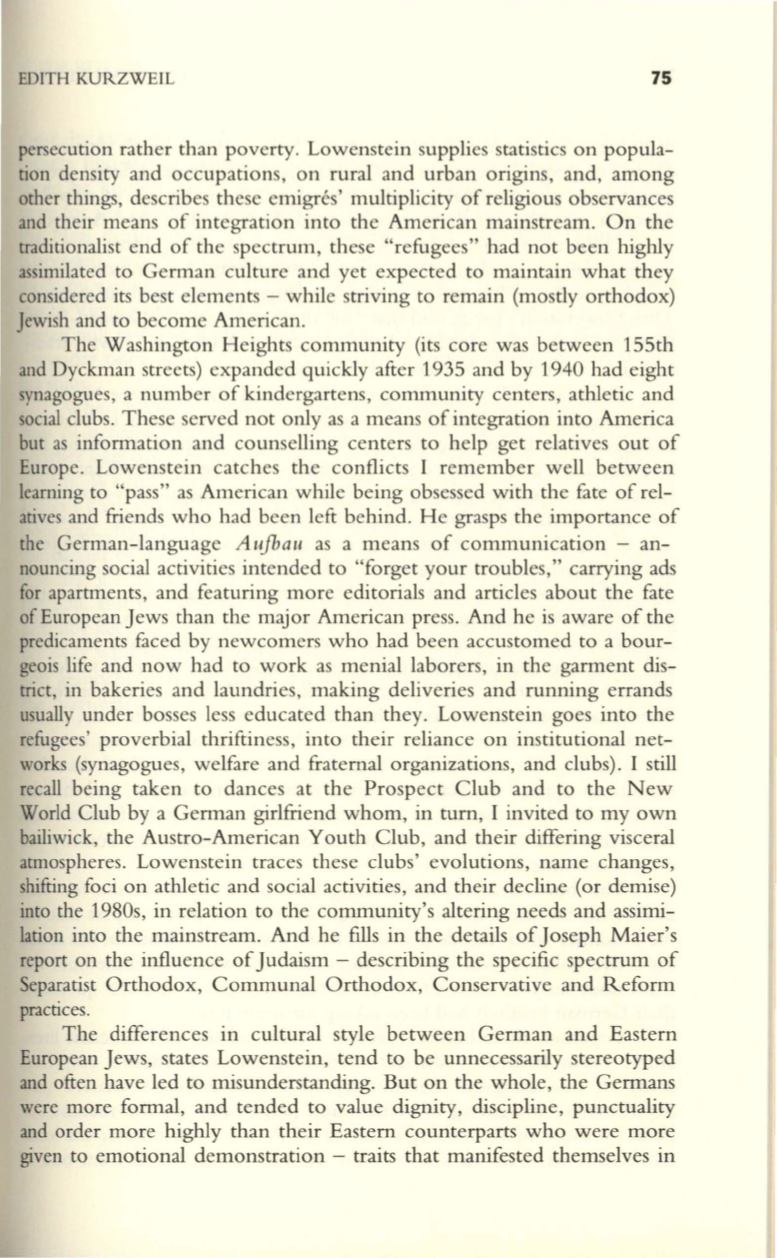
EDITH KURZWEIL
75
persecution rather than poverty. Lowenstein supplies statistics on popula–
tion density and occupations, on rural and urban origins, and, among
other things , describes these emigres' multiplicity of religious observances
and their means of integration into the American mainstream. On the
traditionalist end of the spectrum, these "refugees" had not been highly
assimilated to German culture and yet expected to maintain what they
considered its best elements - while striving to remain (mostly orthodox)
Jewish and to become American.
The Washington Heights community (its core was between 155th
and Dyckman streets) expanded quickly after 1935 and by 1940 had eight
synagogues, a number of kindergartens, community centers, athletic and
social clubs. These served not only as a means of integration into America
but as information and counselling centers to help get relatives out of
Europe. Lowenstein catches the conflicts I remember well between
leaming to "pass" as American while being obsessed with the fate of rel–
atives and friends who had been left behind. He grasps the importance of
the German-language
AuJbau
as a means of communication - an–
nouncing social activities intended to "forget your troubles," carrying ads
for apartments, and featuring more editorials and articles about the fate
of European jews than the major American press. And he is aware of the
predicaments faced by newcomers who had been accustomed to a bour–
geois life and now had to work as menial laborers, in the garment dis–
trict, in bakeries and laundries, making deliveries and running errands
usually under bosses less educated than they. Lowenstein goes into the
refugees' proverbial thriftiness, into their reliance on institutional net–
works (synagogues, welfare and fraternal organizations, and clubs). I still
recall being taken to dances at the Prospect Club and to the New
World Club by a German girlfriend whom, in turn, I invited to my own
bailiwick, the Austro-American Youth Club, and their differing visceral
atmospheres. Lowenstein traces these clubs' evolutions, name changes,
shifting foci on athletic and social activities, and their decline (or demise)
into the 1980s, in relation to the community's altering needs and assimi–
lation into the mainstream. And he fills in the details of joseph Maier's
report on the influence of judaism - describing the specific spectrum of
Separatist Orthodox, Communal Orthodox, Conservative and Reform
practices.
The differences in cultural style between German and Eastern
European jews, states Lowenstein, tend to be unnecessarily stereotyped
and often have led to misunderstanding. But on the whole, the Germans
were more formal, and tended to value dignity, discipline, punctuality
and order more highly than their Eastern counterparts who were more
given to emotional demonstration - traits that manifested themselves in


